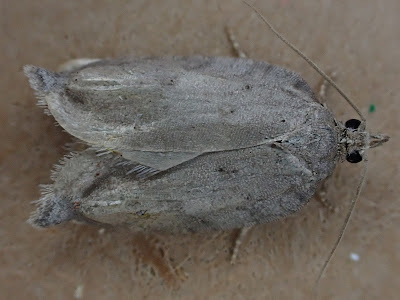 |
| Satellite, Westcott 29th November |
Pages
Tuesday, 30 November 2021
Westcott, Bucks
Friday, 26 November 2021
Mine on oak leaf
I believe this mine on oak is either Stigmella roborella, ruficapitella or atricapitella. If so, can one can get any further? I assume the larva has left and pupation has occurred, but there seems to be no visible exit hole!
Thursday, 25 November 2021
Acleris notana??
I know this can be variable, and not sure what else it can be. Please put me straight.
Best wishes
David
Mompha species
 |
| Likely Mompha jurassicella, Westcott 24th November |
Saturday, 20 November 2021
Pale Brindled Beauty
Assuming I have the ID correct, (I spent a while trying to turn it into a Mottled Umber before the penny droppped!), a very early Pale Brindled Beauty in the MV trap last night.
Phil T
Black-spotted Chestnut
Robin Knill-Jones had his first Black-spotted Chestnut of the season in Denham, Bucks last night. Surely by now someone else in south Bucks must start getting this species! It has already made appearances at two or three sites in Bedfordshire over the past couple of weeks.
 |
| Black-spotted Chestnut, Denham 19th November |
Friday, 19 November 2021
Pseudargyrotoza conwagana and new photo
Having now got a better photo of the deformed micro from my previous post against a neutral background I think Acleris sparsana looks most likely.
Last night's rather disappointing catch did include a late Pseudargyrotoza conwagana.
Andy Newbold, Sibford Ferris. Oxon.
Wednesday, 17 November 2021
Tuesday, 16 November 2021
Caterpillar--Angle Shades?
I found this rather fat green caterpillar in one of my gardening gloves when I put it on this afternoon! I think it's Angle Shades? Was it thinking of pupating there I wonder?
2021 isn't over yet...
 |
| Scarce Umber, Westcott 15th November |
Dave Wilton Westcott, Bucks
Monday, 15 November 2021
Another Epiphyas postvittana?
This micro from last night appeared very different by torchlight but on closer examination the apparently pointed wings are actually the hindwings protruding. It is just over 10mm in length. I suspect just another Epiphyas postivittana?
Andy Newbold, Sibford Ferris, Oxon.
Sunday, 14 November 2021
Two micro puzzles in moth trap
This one is new to me - looks like it could be Tachystola acroxantha which I read is an import from Australia.
Saturday, 13 November 2021
Westcott, Bucks
 |
| Likely Acleris ferrugana, Westcott 12th November |
 |
| Acleris schalleriana, Westcott 12th November |
 |
| Acleris variegana, Westcott 12th November |
 |
| Epiphyas postvittana male, Westcott 12th November |
 |
| Epiphyas postvittana female, Westcott 12th November |
Caterpillar in moth trap
Friday, 12 November 2021
Plumed Prominent
Ched George had a male Plumed Prominent to his outside light last night. This is quite remarkable because Ched lives in Radnage, near Stokenchurch, so this is in a completely new tetrad and marks the first ever Bucks record from north of the M40 (all our previous sightings have been in a tight cluster to the south of the motorway). Could this smart little moth be on the move? Or maybe we've been overlooking it away from the usual sites!
 |
| Plumed Prominent, Radnage 11th November |
Thursday, 11 November 2021
Bordered Beauty
I was a bit surprised to find this in the trap this morning, since the flight period is quoted as Jul-Sept. The Moth Atlas histogram shows one tiny bar at the end of Oct/beginning of Nov, but it looks like a 1970-1979 record, and indeed it suggests the flight period has moved earlier. Could it be a second generation, or is it just very late?
Phil T
Wednesday, 10 November 2021
Red Sword-grass
 |
| Red Sword-grass, Westcott 9th November |
 |
| Plumed Prominent, 9th November |
 |
| Diurnea lipsiella, 9th November |
 |
| Barred Hook-tip, 9th November |
Stoke Goldington, Bucks
A reasonable night with a garden record of 10 Sprawler (none of which were actually inside the Skinner trap). Also, this rather plain looking micro which I'm making guess at Blastobasis lacticolella, but willing to be corrected.
Tuesday, 9 November 2021
Westcott, Bucks
 |
| December Moth, Westcott 8th November |
 |
| Acleris kochiella, Westcott 8th November |
Sunday, 7 November 2021
A bit of a challenge
I will be pleasantly surprised if anyone can ID this little chap, found in a crack in the plaster at my grandchildren's house and rescued by the post-booster NHS leaflet which I had on me at the time. Moths very sparse now but I've had interesting encounters with a very lively hedgehog, a drowned baby grass snake and a roadkill otter, found on the Banbury Road verge. The Environment Agency collected it the following morning to send to Cardiff University where otter autopsies apparently provide lots of interesting info. Martin Wainwright, Thrupp, Oxon
Acleris sparsana - at last
 |
| Acleris sparsana, Westcott 6th November |
Thursday, 4 November 2021
Dusky Brocade?
Thanks
Phil T
Mottled Umber
 |
| Mottled Umber, Westcott 3rd November |
Monday, 1 November 2021
Another couple of queries
I think the top one, from mid-October is a very dark Lunar Underwing, but the wingtip shape looks more like Beaded Chestnut - and it's SO DARK!
The second looks like an Acleris or Pandemis to me, but no species in the book looks quite right. Is it one of the very variable ones?
And No3 is so featureless, I'm not sure at all - is it just a very plain Chestnut?
Thanks in advance for any guidance.
David
Westcott, Bucks
 |
| Tawny Pinion, Westcott 23rd October |
 |
| Cydalima perspectalis, Westcott 27th October |
 |
| Winter Moth, Westcott 29th October |
 |
| Stigmella species, Westcott 28th October |



















